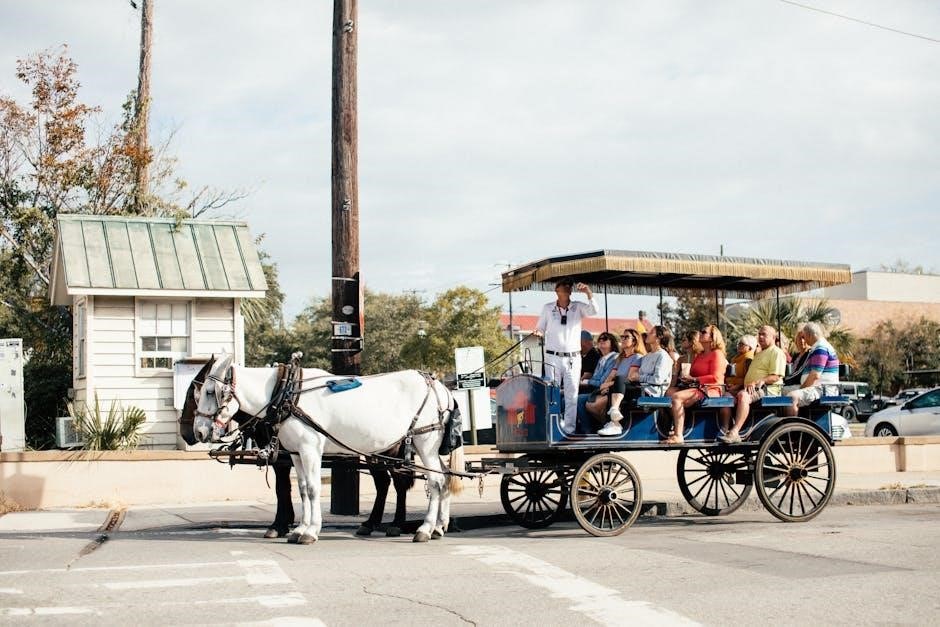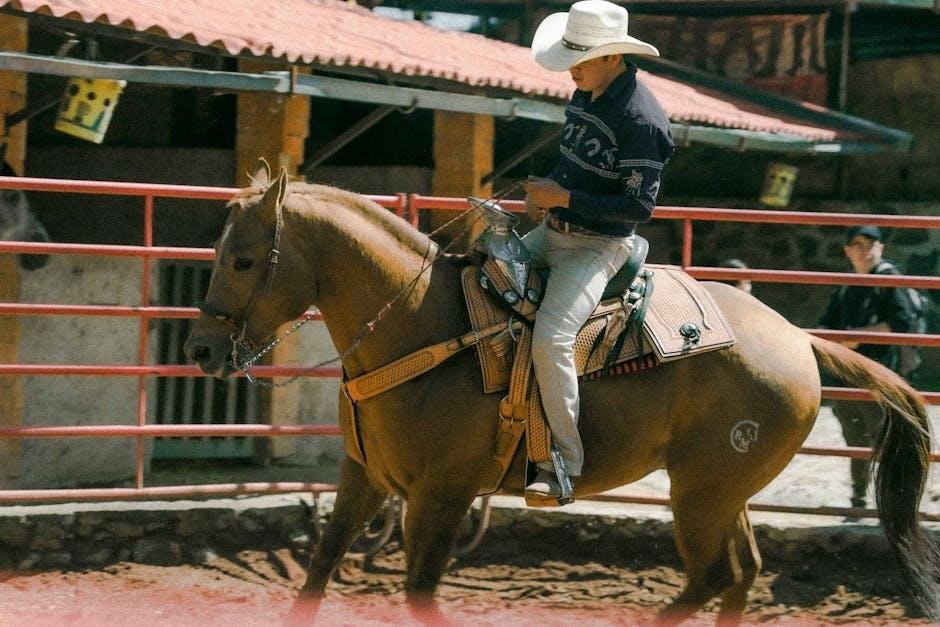Horse blanketing guide provides essential information on horse care and management, helping owners make informed decisions about their horse’s comfort and well-being, with a focus on temperature and blanket selection always․
Purpose of Horse Blanketing
The purpose of horse blanketing is to provide protection and comfort to horses in various weather conditions, as outlined in a comprehensive horse blanketing guide․ This guide helps owners understand the importance of blanketing in maintaining their horse’s overall health and well-being․ By using a horse blanket, owners can help regulate their horse’s body temperature, preventing heat loss and discomfort․ A horse blanketing guide typically covers the different types of blankets available, including lightweight, medium-weight, and heavyweight options, each designed to serve a specific purpose․ The guide also discusses the factors to consider when selecting a blanket, such as the horse’s age, breed, and climate․ Additionally, it provides tips on how to properly fit and care for a horse blanket, ensuring it remains effective and comfortable for the horse․ Overall, the purpose of horse blanketing is to promote the horse’s comfort, health, and happiness․
Importance of Choosing the Right Blanket
Choosing the right blanket is crucial for a horse’s comfort and well-being, as emphasized in a horse blanketing guide․ A well-chosen blanket can help prevent discomfort, stress, and even health issues․ The guide stresses the importance of considering factors such as the horse’s size, breed, and climate when selecting a blanket․ A blanket that is too heavy or too light can be detrimental to the horse’s health, making it essential to choose a blanket that meets the horse’s specific needs․ By selecting the right blanket, owners can help ensure their horse remains comfortable and healthy, even in extreme weather conditions․ The guide provides valuable insights and tips on how to choose the right blanket, helping owners make informed decisions․ With the right blanket, owners can promote their horse’s overall well-being and happiness, making it an essential aspect of horse care and management․ Proper blanket selection is vital for horse owners․

Understanding Blanket Materials and Fill
Horse blanketing guide explains materials and fill types, helping owners understand their options and make informed decisions about their horse’s blanket, considering factors like durability always․
Denier and Fill Explained
The denier and fill of a horse blanket are crucial factors to consider when selecting the right blanket for your horse․ Denier refers to the thickness of the blanket’s threads, with higher denier ratings indicating a more durable blanket․ Fill, on the other hand, refers to the amount of insulation provided by the blanket․ A higher fill rating means a warmer blanket․ Understanding denier and fill is essential to choosing a blanket that meets your horse’s specific needs․ A horse blanketing guide can provide valuable information on denier and fill, helping you make an informed decision․ By considering factors like climate, temperature, and your horse’s individual needs, you can select a blanket with the right denier and fill to keep your horse comfortable and healthy․ This knowledge will help you navigate the various options available and make the best choice for your horse․
Blanket Warmth and Weight
Blanket warmth and weight are critical factors in determining the right blanket for your horse․ The warmth of a blanket is measured by its ability to retain heat, while the weight refers to the blanket’s overall heaviness․ A horse blanketing guide can help you understand the different levels of warmth and weight available in horse blankets․ Lighter blankets are suitable for milder climates, while heavier blankets are better suited for colder temperatures․ The weight of a blanket can also affect your horse’s mobility and comfort․ A well-balanced blanket should provide sufficient warmth without being too heavy or restrictive․ By considering the specific needs of your horse, you can choose a blanket that provides the right level of warmth and weight․ This will help ensure your horse remains comfortable and healthy throughout the year․ Proper blanket selection is essential for maintaining your horse’s overall well-being․

Guidelines for Blanketing Horses
Understanding horse blanketing guidelines is crucial for horse owners to ensure proper care and management always and provide necessary information․
Temperature Guidelines for Blanketing
Temperature guidelines for blanketing horses are essential to ensure their comfort and well-being․ The decision to blanket a horse depends on various factors, including the temperature, humidity, and wind chill․ Generally, horses need to be blanketed when the temperature drops below a certain threshold, typically around 40-50 degrees Fahrenheit․ However, this can vary depending on the individual horse, its age, health, and coat condition․ A horse blanketing guide can provide more specific temperature guidelines, taking into account the horse’s breed, size, and climate․ For example, horses in colder climates may need to be blanketed at higher temperatures than those in warmer climates․ Additionally, horses that are clipped or have a thin coat may need to be blanketed at higher temperatures than those with a thick coat․ By following temperature guidelines for blanketing, horse owners can help keep their horses warm and comfortable during the cold winter months․
When to Blanket a Horse
Determining when to blanket a horse is crucial to its health and comfort․ A horse blanketing guide can help owners decide when to blanket their horse, considering factors such as climate, temperature, and the horse’s individual needs․ Generally, horses should be blanketed when they are exposed to cold temperatures, especially if they are clipped or have a thin coat․ However, over-blanketing can be detrimental to a horse’s health, so it’s essential to monitor their condition and adjust the blanketing accordingly․ Horse owners should also consider the horse’s age, health, and level of activity when deciding when to blanket․ By consulting a horse blanketing guide and considering these factors, owners can make informed decisions about when to blanket their horse, ensuring its comfort and well-being․ This guide provides valuable information to help horse owners make the right decision for their horse’s specific needs and circumstances always․

Choosing the Right Blanket for Your Horse
Horse owners need to consider size and material when selecting a blanket for their horse always․
Factors to Consider When Selecting a Blanket
When choosing a blanket for your horse, there are several factors to consider, including the horse’s age, size, and breed, as well as the climate and weather conditions they will be exposed to․ The level of care and management the horse receives is also an important consideration, as some blankets require more maintenance than others․ Additionally, the horse’s individual needs and preferences should be taken into account, such as their sensitivity to certain materials or their tendency to rub or chew on their blanket․ By considering these factors, you can select a blanket that meets your horse’s unique needs and provides them with the comfort and protection they require․ A well-chosen blanket can help to keep your horse warm, dry, and comfortable, and can also help to prevent health problems such as chilling and skin irritation․ Overall, selecting the right blanket is an important decision that can have a significant impact on your horse’s health and well-being․
Benefits of Using the Right Blanket
Using the right blanket for your horse can have numerous benefits, including improved comfort and reduced stress․ A well-fitting blanket can help to regulate your horse’s body temperature, keeping them warm in cold weather and cool in warm weather․ This can be especially important for horses that are clipped or have thin coats, as they may be more susceptible to temperature extremes․ By providing your horse with a comfortable and well-fitting blanket, you can help to improve their overall health and well-being․ A good blanket can also help to prevent health problems such as chilling and skin irritation, which can be painful and uncomfortable for your horse․ Overall, using the right blanket is an important part of horse care and can have a significant impact on your horse’s quality of life․ Regular use of a suitable blanket can also promote healthy coat growth and development․